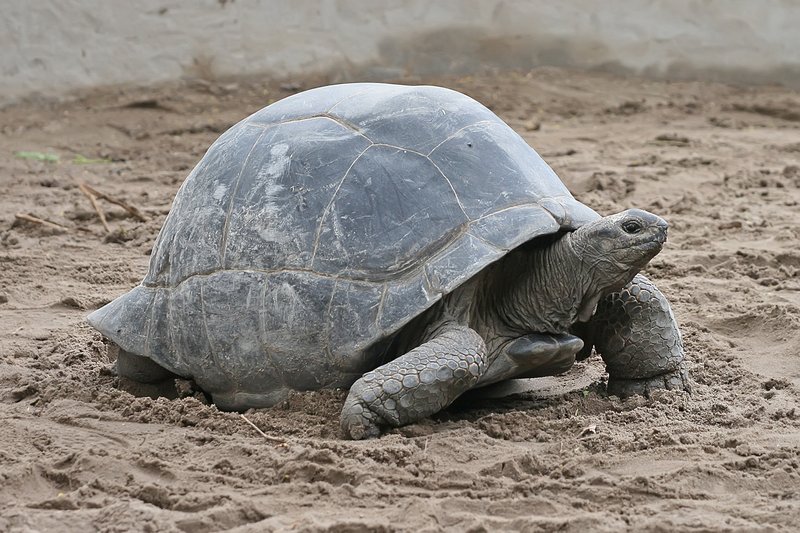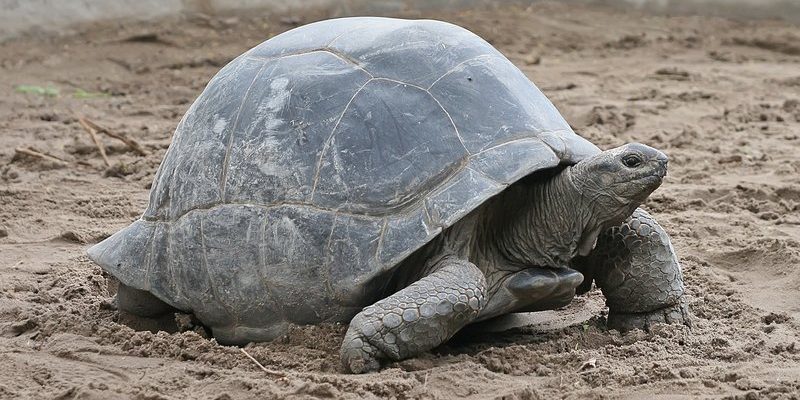
Now, let’s dive into some surprising things about this majestic reptile. Whether you’re a wildlife enthusiast or just someone curious about the wonders of nature, I promise you’ll discover something new here.
1. They’re One of the Largest Tortoise Species
The Aldabra giant tortoise can weigh an astonishing up to 550 pounds (250 kilograms) and can grow to about 4 feet long (1.2 meters). To put that in perspective, that’s roughly the size of a small child! These tortoises are not only massive but also carry an impressive shell that can be as big as a small coffee table. Their size is one of the key reasons they stand out among other tortoise species.
But it’s not just about their size; their shell is uniquely shaped, which helps protect them from predators. Unlike smaller tortoises, an Aldabra’s shell acts as a fortress, making it difficult for animals to penetrate.
2. They Can Live for Over a Century
Imagine celebrating your 100th birthday surrounded by friends and family. For the Aldabra giant tortoise, that’s no big deal! These tortoises are known to live for over 100 years, with some reported to reach ages of up to 200 years. That means they could have seen the world change dramatically, witnessing different generations of humans grow and evolve.
In fact, one famous Aldabra tortoise named Mzee lived to be about 176 years old! Can you imagine the stories he could tell? Their long lifespan makes them one of the longest-living land vertebrates on the planet.
3. They Play a Key Role in Their Ecosystem
You might be wondering, what do these giant tortoises do besides bask in the sun? Well, they serve an essential role in their habitat. As herbivores, Aldabra giant tortoises eat a variety of plants, including grasses, leaves, and fruits. By grazing on vegetation, they help maintain the balance of plant life in their environment.
Their eating habits also contribute to seed dispersal. When they consume fruits, the seeds pass through their digestive system and get dropped in new locations. This process helps promote new plant growth, which is crucial for maintaining a healthy ecosystem on the atoll.
4. They Have Unique Mating Rituals
If you think romance is only for us humans, think again! Aldabra giant tortoises are known for their unique mating rituals. During the breeding season, males will often engage in a courtship display where they might engage in head-bobbing and vocalizations to attract females.
It’s like their version of love songs! Once a male has caught a female’s attention, they may mate several times during the breeding season. After mating, the female lays around 10 to 15 eggs in a pit and leaves them to incubate for about 120 days.
5. They Can Move Surprisingly Fast
Sure, you’ve seen pictures of these tortoises moving slowly, and they can be quite leisurely. But did you know that they can actually move at a pace of up to 1 mile per hour (1.6 km/h) when they want to? While that may not seem speedy compared to other animals, it’s pretty fast for a tortoise!
This burst of speed often comes in handy when they’re searching for food or protecting themselves from potential threats. Just imagine, a giant tortoise running towards its lunch!
6. Their Population Declined Dramatically
Sadly, the Aldabra giant tortoise faced significant threats in the past. In the 19th century, they were heavily hunted for their meat, which caused their population to plummet. At one point, they were on the brink of extinction due to over-exploitation and habitat loss.
However, thanks to conservation efforts, their numbers have rebounded significantly. Today, they are considered vulnerable, with conservation programs actively working to protect their habitats and ensure their survival.
7. They Can Store Water for Long Periods
Here’s a fun fact: Aldabra giant tortoises can store water in their bodies for extended periods. This ability allows them to thrive in the sometimes dry environment of the Aldabra Atoll.
When food and water are scarce, they can survive for months without drinking, relying on the moisture from the plants they consume. Honestly, it’s a survival tactic that’s pretty impressive when you think about it!
8. They Have Strong Personalities
You might not think of tortoises as having personalities, but the Aldabra giant tortoise certainly does! These creatures can be quite social with one another. They establish social hierarchies, often displaying behavior that shows their mood—whether that’s curiosity, aggression, or even playfulness.
When you watch them interact, it’s easy to see they have their own quirks. Some may be more adventurous, while others prefer to lounge in their favorite sunny spot. Each tortoise has its own unique character, making them even more fascinating to observe.
9. They Have Unique Shell Shapes
The shape of an Aldabra giant tortoise’s shell is not just for looks; it serves practical purposes too. Their domed, high shells provide protection while allowing for greater mobility. Interestingly, their shell shape can vary depending on their habitat.
For example, tortoises living in areas with more vegetation tend to have flatter shells, which help them navigate through thick brush. In contrast, those from more arid environments often have more rounded shells. This adaptability showcases their incredible evolutionary traits.
10. They’re a Conservation Success Story
After facing near extinction, the Aldabra giant tortoise represents a significant conservation success story. Various organizations and local governments have collaborated to protect their habitats and create sanctuaries.
Thanks to these efforts, today, they’re thriving once again! Visitors to the Aldabra Atoll often marvel at the sight of these magnificent creatures roaming freely. It’s a reminder of how important conservation is for preserving our planet’s biodiversity.
The Aldabra giant tortoise truly is a remarkable species. From their impressive lifespans to their critical role in their ecosystem, there’s a lot to appreciate about these gentle giants. Who knew that behind those tough shells lies such a rich tapestry of life? Let’s keep learning and supporting the conservation of these incredible creatures so future generations can enjoy their company too!

